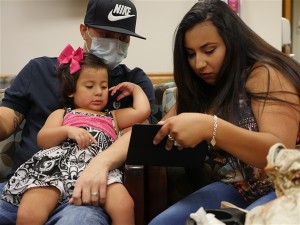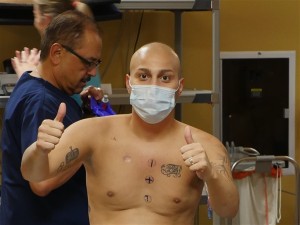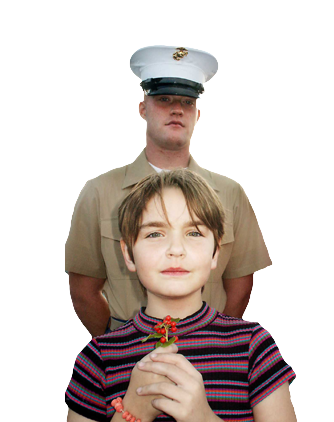 Army Pfc. Gustavo Moreno celebrates after his last in a series of radiation treatments for T-cell Acute Lymphoblastic Lymphoma at San Antonio Military Medical Center, Fort Sam Houston, Texas, July 20, 2015. Moreno was diagnosed with cancer in January 2014. U.S. Army photo by Robert Whetstone JOINT BASE SAN ANTONIO-FORT SAM HOUSTON, Texas, Aug. 5, 2015 – When Army Pfc. Gustavo Moreno recited the oath of enlistment, he knew he was charged to defend his country against all enemies. What he didn't know is that shortly after completing basic combat training, he'd be fighting a different enemy altogether.
Army Pfc. Gustavo Moreno celebrates after his last in a series of radiation treatments for T-cell Acute Lymphoblastic Lymphoma at San Antonio Military Medical Center, Fort Sam Houston, Texas, July 20, 2015. Moreno was diagnosed with cancer in January 2014. U.S. Army photo by Robert Whetstone JOINT BASE SAN ANTONIO-FORT SAM HOUSTON, Texas, Aug. 5, 2015 – When Army Pfc. Gustavo Moreno recited the oath of enlistment, he knew he was charged to defend his country against all enemies. What he didn't know is that shortly after completing basic combat training, he'd be fighting a different enemy altogether.
Born and raised in San Antonio, Texas, Moreno, a self-confessed basketball junkie and Spurs fanatic, found himself in a very grown-up situation during his senior year of high school: He was going to be a father. Moreno said he knew he had to do something as soon as possible. He had to step up and be there for his then-girlfriend and now-wife, Valerie Hernandez, and their daughter, Avalee. While Hernandez remained home, Moreno went to Fort Sill, Oklahoma, for basic training. “I went in October 2013 and didn’t come back till December,” Moreno said. After a brief trip home following basic training, Moreno returned to Fort Sill in January 2014 for advanced individual training.
Warning Signs “I was doing [physical training]. I was really fit,” Moreno said. “I ran a 13:52 2-mile, did 80 push-ups in 2 minutes, and something like 78 sit-ups in 2 minutes. And all of a sudden, I started losing my breath. I’d get dizzy.” While he was lying on the top bunk bed and talking to Hernandez on the phone, Moreno said he recalls feeling nauseated and dizzy, and then blacking out. “I fell off the bed, went downstairs and was taken to the hospital,” he said. “At first they thought it was bronchitis because I had a cough and it was hard to swallow.” It turns out Moreno had a 14-centimeter mass compressing his trachea. Moreno was diagnosed with T-cell Acute Lymphoblastic Lymphoma, or ALL, a rare subtype of adult non-Hodgkin cancer, commonly treated with intensive chemotherapy. When Moreno was diagnosed, he said, “I was laughing, like I was in shock. I knew what cancer was, but I didn't know what [this] was, especially when it comes to blood cells and all of that.” ALL is a type of blood cancer. It is the most aggressive leukemia in adults.ALL starts from white blood cells in the bone marrow and develops from cells called lymphocytes. It invades the blood and can spread throughout the body to other organs. Without treatment, it can be fatal in a few short months. According to the National Marrow Donor Program website, someone is diagnosed with a type of blood cancer every three minutes. It can happen to anyone at any time.
 Army Pfc. Gustavo Moreno celebrates after his last in a series of radiation treatments for T-cell Acute Lymphoblastic Lymphoma
Army Pfc. Gustavo Moreno celebrates after his last in a series of radiation treatments for T-cell Acute Lymphoblastic Lymphoma
‘Keep on Fighting, Every Day’ Moreno had the task of calling his wife to break the news to her. He said her father had passed away three years prior, and the thought of losing him, with their new daughter being so young, was difficult. “I'm not going to leave them,” Moreno said. “I'm going to keep on fighting, every day.” After the diagnosis, Moreno returned home to San Antonio and Brooke Army Medical Center to begin his chemotherapy. After one year of intensive treatment, he had a complete response and appeared to be free of cancer. Things were going well as he continued on low intensity therapy, but Moreno experienced a setback -- the mass returned and spread to his blood. He was referred to the MD Anderson Cancer Center at the University of Texas in Houston for therapy and entered into a clinical trial with an investigational drug. When he did not respond, he returned to San Antonio Military Medical Center for treatment. A bone marrow transplant, also called a stem cell transplant, is a procedure that infuses healthy cells, called stem cells, into your body to replace damaged or diseased bone marrow. Moreno is now reaching this point in his battle. Today, doctors are controlling Moreno's cancer with radiation and chemotherapy. “I'm hoping to get into remission enough to where I can still get the transplant,” Moreno said.
Bone Marrow Donors Needed Donor awareness is extremely important to Moreno and Hernandez -- especially since minorities, particularly Hispanics, make up less than 10 percent of donors on the national registry. “Even if I don't find a match, it's just something that needs to be out there, and more people need to hear about it,” Moreno said. “More minorities and Hispanics need to join the registry.” “There are a lot of people who think that it hurts, so they don't donate," Hernandez said. “When they hear, ‘bone marrow transplant,’ they think ‘I'm going to be stuck with needles,’” Moreno said. “It's just like donating blood. Honestly, you're just giving of yourself to someone else, that way they can fight off the infection with your good cells. They might hurt a little bit, but they don't see everything we go through.” Doctors gave Moreno a few months to live, but he still has hope. “There is always hope,” Moreno said emphatically. “Even if the doctors say one thing, God has the last word.”
How to Become a Donor Hope can come in the form of myriad organizations working tirelessly to help people like Moreno. One organization, the C.W. Bill Young Department of Defense Marrow Donor Program -- also known as Salute to Life, provides assistance to those individuals seeking to join the national registry of volunteer marrow and stem cell donors. Service members, military retirees and Defense Department civilian personnel who are between the ages of 18 and 60 and of good health can join by completing a simple cheek swab. A list of installation-based recruitment drives, walk-in sites, and information about requesting individual registration kits is available at https://www.salutetolife.org. “Approximately 70 percent of patients are unable to find a match within their own families and must turn to the network of volunteer donors for help,” said Kathryn Branstad, donor quality and retention manager for the C.W. Bill Young DoD Marrow Donor Program. “Our donors are amazing individuals, willing to temporarily disrupt their daily lives and give of themselves in a most profound manner in order to offer hope to someone they’ve never even met,” she said. Hope also comes from a solid support system. “I'm glad I was born and raised here [in San Antonio],” said Moreno. “I have all my family here. My wife's family is here, and that helps out a lot. “The nurses and staff up there in 5T [the San Antonio Military Medical Center Bone Marrow Unit and Outpatient Clinic], they're great,” he added. “They don't just look at you like a cancer patient -- they look at you like a friend." True to the Soldier’s Creed, Moreno's message to those who are in the same situation as he is to “never quit.” And he has a message for those who don't know anything about his fight: "This is really important, I just want you to hear me, and please pay attention. You can save somebody's life.”
EDITOR’S NOTE: After nearly a two year battle with T-cell Acute Lymphoblastic Lymphoma, on the day he was promoted, Army Spc. Gustavo Moreno passed away July 24, 2015. He was surrounded by his wife Valerie Hernandez, daughter Avalee, family members, and a host of soldiers from his unit, Warrior Transition Battalion, Brooke Army Medical Center, Fort Sam Houston, Texas. Moreno was 20 years old.
Written Aug 5, 2015 By: Robert A. Whetstone Brooke Army Medical Center
Republished and redistributed by SOT by permission of DOD






